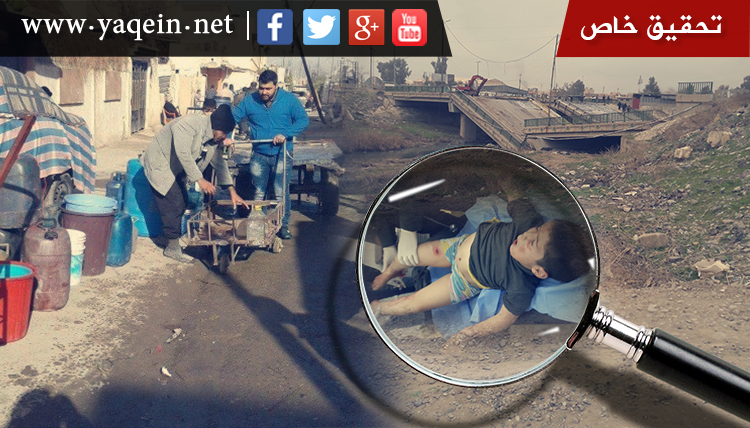US-Led Coalition Air
Strikes on Mosul Destroyed Water Network, Leading to Humanitarian
Disaster, and Spread of Diseases
February 13, 2017
Editor's Note:
The coalition which fights the Islamic State and other Sunni groups in
Syria consists of US-led NATO forces, Russian forces, Syrian Alewite government forces,
Iranian-backed Shi'i militias, and Kurdish peshmerga forces. The
coalition's continuous attacks have resulted in the killing of thousands
of Iraqi and Syrian Sunni Muslim Arabs and the eviction of millions of
them as a result of
the destruction of their cities and villages.
The end outcome is going to be the weakening and possible dismantling of
Iraqi and Syrian states as well as the eviction
(ethnic cleansing of)
Sunni Muslim Arabs, particularly from the upper Euphrates region of northwestern Iraq
and northeastern Syria.
The larger context for understanding the Syrian war (and other wars in
the Middle East) is that it contributes to the implementation of the Zionist-Israeli plan of destroying the Arab
Middle Eastern states in preparation for the establishment of the
greater Israeli empire, from the Nile of Egypt to the Euphrates of
Iraq.
For a background, read:
Zionist Creative Destruction of the Middle East
for the Benefit of the Apartheid Israeli Regime
Continuous US-Led Coalition Attacks on
Mosul Roads Destroyed Water-Pipe Network, Leading to a Humanitarian
Disaster, No Running Water, and the Spread of Diseases
A report in Arabic by http://yaqein.net/AR/details9732.htm :
يقين” في نينوى: 750 الف نسمة في الموصل بلا مياه منذ 3 اشهر
http://yaqein.net/AR/details9732.htm
قسم
التحقيقات - الموصل
بعد إعلان حيدر
العبادي نهاية شهر كانون الثاني الماضي استعادة القوات
الامنية الجانب الايسر من مدينة الموصل - مركز محافظة
نينوى - بالكامل من سيطرة "تنظيم الدولة" - الذي كان
قد احكم سيطرته عليها في شهر حزيران من عام 2014 -
وبعد قرابة ثلاثة أشهر من بدء عمليات "قادمون يا
نينوى" بدأت مشكلة انعدام مياه الشرب عن غالبية مناطق
الجانب الايسر "الشرقي" من المدينة تطفو على سطح مدينة
الموصل المنكوبة لتنذر بأزمة انسانية يمكن وصفها
بالكارثية ولتبدأ معها معاناة السكان اليومية في
الحصول على المياه سواء كانت صالحة للشرب او لا، بعد
أن كانت مياه الشرب تصل الاحياء السكنية والبيوت عبر
شبكة الانابيب الرسمية.
تقع مدينة الموصل -
مركز محافظة نينوى- العراقية شمال البلاد وتبعد عن
بغداد حوالي 400 كم ويصل عدد سكان الموصل الى مليون
وسبعمائة وخمسين الف نسمة موزعين على جانبي المدينة
الايسر والايمن، يخترق نهر دجلة الموصل ليقسمها الى
شطرين شرقي وغربي وتعتمد المدينة في توفير مياه
الاسالة على نهر دجلة حيث أن جميع مشاريع المياه في
المدينة تقع على ضفتي النهر ومع استعادة القوات
العراقية السيطرة على الجانب الايسر بات ما يزيد على
750 الف نسمة بلا مياه نتيجة تضرر مشاريع المياه بفعل
العمليات العسكرية التي شهدها هذا الجزء من المدينة.
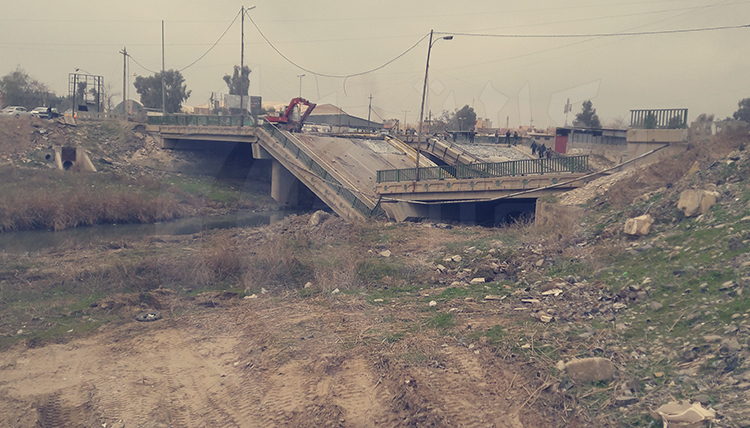
الاسباب
الرئيسة في انقطاع المياه
تعزى أسباب انقطاع
المياه عن الجانب الايسر الى سببين رئيسيين اولهما
تضرر شبكة الانابيب الرئيسة الناقلة للمياه
نتيجة القصف الجوي
للتحالف الدولي لتقاطعات الطرق
بصواريخ ارتجاجية أدت الى تكسر وتفجر أنابيب المياه،
أما السبب الثاني فيرجع الى توقف مشاريع المياه
وخروجها عن الخدمة.
لجأ سكان الموصل في
الجانب الايسر الى الاعتماد على مياه الابار الجوفية
في حياتهم اليومية رغم معرفتهم بخطورة استخدامها وعدم
موافقتها للمعايير الصحية.
ولأجل الاطلاع على مزيد من
الحقائق العلمية عن المياه الجوفية ووفرتها في الموصل
توصلنا الى الاستاذ رضوان حامد النعيمي وهو
محاضر سابق في جامعة الموصل في قسم علوم الارض حيث قال
إن الموصل تتميز بتربتها الخازنة للمياه، فطبقات الارض
في الموصل تتميز بقدرتها على حفظ المياه الى حد كبير
وبالتالي ونتيجة لكون الموصل تقع ضمن المناطق السهلية
اضافة الى اختراق نهر دجلة للمدينة، كل هذا ساعد وعبر
الاف السنين على تخزين الارض للمياه، ولا ننسى ايضا سد
الموصل الذي أنشأ في ثمانينات القرن الماضي حيث أدى
ضغط المياه الهائل في بحيرة السد الى تخلخل المياه الى
باطن الارض. واضاف أنه لا توجد دراسة حديثة لحجم
المياه الجوفية واخر دراسة علمية دقيقة كانت في
ثمانينات القرن الماضي لكن استطيع القول أن المدينة
تضم في باطنها مخزونا هائلا من المياه، وتختلف نوعية
هذه المياه وفقا لنوع التربة والعمق والقرب من نهر
دجلة.
وحول طرق استخراج
هذه المياه من باطن الارض اضاف النعيمي أن طرق استخراج
المياه الجوفية تتنوع من خلال طرق الحفر ونوع الابار
المستهدفة لكن في الموصل على وجه الخصوص تنقسم طرق
الاستخراج الى نوعين، اولهما الابار الارتوازية
النظامية التي تكون من خلال اليات الحفر والتي تستهدف
عمق 30 مترا فما فوق ويعتمد هذا الرقم على المنطقة
وعلى البعد عن نهر دجلة وعلى المسح الجيولوجي
للاخصائيين فليست كل منطقة صالحة لحفر الابار فهناك
مناطق تخلخل للمياه يحددها الجيلوجيون تكون فيها
الابار ذات ديمومة طويلة، فإذا ما تم الحفر عشوائيا
فإن انسيابية هذه الابار ستكون مؤقتة وقد يفاجأ الناس
بنضوبها بعد مدة.
اما القسم الثاني
فيمكن تسميته بالابار البدائية التي تعتمد مفهوم
الابار الارتوازية لكن بصورة بدائية وهي الحفر اليدوي
الى عمق 7-15 مترا وهذه تكون في المناطق المحاذية
للنهر واضاف ايضا أن الحفر الى مستوى اقل من هذا داخل
الموصل امر خاطىء نتيجة كون الطبقة القريبة من السطح
مليئة بالمياه الاسنة الناتجة عن تخلل مياه الصرف
الصحي الى باطن الارض فكما هو معلوم ان مدينة الموصل
ليس فيها نظام صرف صحي للمياه الثقيلة وهذه المياه
تذهب الى جوف الارض وعلى السكان النزول الى مستويات
اعمق في الحفر حتى يصلوا الى المياه الجوفية
المستهدفة.
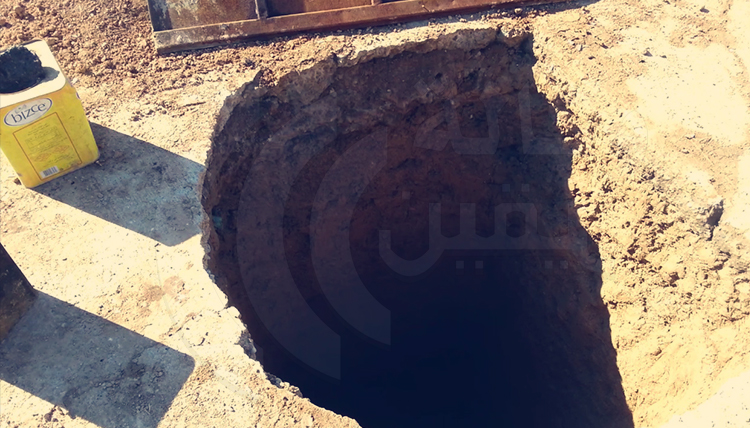
الكارثة
الانسانية ... في اعتماد الناس على مياه الابار
الجوفية
التقينا بحسين
محمـد من سكنة حي الزهراء وهو يعمل على حفر بئر في
منطقته واطلعنا على معاناته مع مياه الابار وما نتجت
عنه، يقول حسين إنه وبعد انقطاع المياه لجأ هو وبعض
السكان الى حفر بئر بمجهود ذاتي وباستخدام معدات بسيطة
تتمثل بالمسحاة والمطرقة، ويضيف أنهم امضوا 10 ايام في
حفر البئر ووصلوا الى عمق 5 امتار وظهرت المياه لكن
المشكلة تتمثل بكون هذه المياه غير صالحة لاي شيء فهي
ذات رائحة كريهة وقذرة ولا تصلح للاستخدام لكن الناس
مضطرة لها لانعدام البديل فالحفر النظامي الى عمق اكبر
مكلف ويحتاج الى معدات ثقيلة ولا تتوفر لدينا
الامكانيات المادية ولا الدعم الحكومي.
يضيف حسين ايضا أن التقصير
الحكومي واضح في توفير المياه للسكان ونتيجة لذلك تعرض
اطفاله والكثير من سكان تلك المنطقة الى امراض معوية
كالاسهال والمغص. وعند استفسارنا منه عن استخدام مياه
الخزانات التابعة لليونيسيف؟ قال: "إن حصة الفرد
منها لا تتجاوز الـ 20 لترا في اليوم وأضاف متعجبا:
"استخدمها للطبخ ام للغسيل ام للاستحمام؟!”.
سارت بنا الخطى الى منطقة
اخرى وهي حي القادسية لنقف على معاناة من نوع اخر
وتحدثنا الى ابراهيم عادل وهو من ميسوري الحال في
المنطقة وكان قد حفر بئرا ارتوازيا نظاميا ليغذي
البيوت القريبة منه لنفاجأ بمشكلة اخرى لا تقل عن التي
سبقتها وتتمثل بأن البئر الذي حفره قبل عام - ادراكا
منه بأن مشكلة المياه ستأتي عاجلا او آجلا - وبعد
استخدامه قرابة 3 اشهر بعد انقطاع مياه الشبكة
بدأ بالنضوب شيئا فشيئا حيث قال: "قمنا بحفر البئر الى
عمق 50 مترا بمجهود شخصي وعلى نفقتنا وحصلنا على
المياه وقمنا بفحصها في المختبرات واخبرونا بأنها غير
صالحة للاستهلاك البشري لاحتواءها على معدلات عالية من
الاملاح والكبريت لكن ورغم ذلك فإن السكان مضطرون
لاستخدامها، فقارورة المياه المعدنية سعة 20 لترا التي
تباع في الاسواق يبلغ ثمنها الفي دينار وليست للناس
القدرة الشرائية خصوصا أن الأزمة مضى عليها 3 اشهر دون
بوادر للحل، يضاف لهذه المشكلة أن البئر اوشك على
الجفاف”.

توسعنا أكثر في
الامر فكان التوجه الى عمق مناطق الجانب الايسر
وتحديدا الى حي الجزائر – وهو من الاحياء الفقيرة -
فكانت المشكلة اكبر ومن نوع اخر لم تكن في الحسبان حيث
تعرضت المنطقة للقصف بقنابر الهاون اثناء تواجدنا وحيث
كان هناك تجمع قريب لبعض السكان امام احد الابار في
طوابير طويلة، وما إن خفت وتيرة القصف حتى تحدثنا الى
أحد المنتظرين في طابور المياه هذا حيث قال إن طفله
البالغ من العمر 6 أعوام تعرض الى اصابة في ساقيه
وبطنه أثناء وقوفه في طابور الحصول على المياه الاسبوع
الماضي نتيجة سقوط قنبرة هاون على مقربة منه مصدرها
الجانب الايمن الغربي من المدينة وان ابنه ما زال يرقد
في فراشه.
لا يملك قسم كبير من سكان
الموصل القدرة على شراء المياه المعدنية فضلا عن حفر
الابار نتيجة الكلفة العالية للحفر والتي تصل الى
مليون دينار عراقي في المتوسط فضلا عن قلة اعداد
الاليات الخاصة بحفر الابار، تحققنا ميدانيا وبحثنا
لمدة ثلاثة ايام عن أحد يوصلنا لاحد مالكي هذه الاليات
ولم نفلح، لكن توصلنا الى الحاج بشار نوفل من سكنة حي
البكر حيث انه كان قد اتم حفر بئر قبل ايام وطلبنا منه
تزويدنا برقم هاتف الشخص الذي يملك حفارة الابار التي
عملت لديه للاستفسار منه عن كلفة الحفر وعن تحديد موعد
لحفر بئر، فاتصلنا به وطلبنا منه موعدا لحفر بئر في
منطقة معينة فكان رده انه لن يستطيع ذلك قبل شهرين من
الان؛ والسبب ان هناك عشرات الابار تنتظر الحفر
ويلزمنا تسجيل موعد لديه!! وعن كلفة الحفر قال إن
تكلفة الحفر فقط - دون بقية مستلزمات البئر من
انابيب ومضخة ومولدة كهربائية وغيره - هي عشرين الف
دينار للمتر الواحد، طلبنا منه ارشادنا الى مالك حفارة
اخرى فقال إن عدد الحفارات في الموصل لا تتجاوز الـ 5
حفارات وكلهم لديهم جداول مزدحمة بالمنتظرين.
لجأ الناس نتيجة
لكل ما سبق الى الاصطفاف في طوابير طويلة بعربات
حديدية بدائية تحمل بعض الأواني في انتظار حصتهم من
المياه امام الابار المنتشرة في المدينة وهذه مشلكة
اخرى حيث أن الناس يضطرون للانتظار ساعة او ساعتين
للحصول على المياه في جو قارس البرودة في فصل الشتاء
حيث تصل درجة الحرارة الى الصفر المئوي.
انتشار
الامراض الناتجة عن شرب مياه الابار والعجز الصحي في
المدينة
كان لا بد من
التوجه الى الدوائر الصحية للوقوف على الاحصائيات
الدقيقة للحالات المرضية فتوجهنا بالامر الى الدكتور
ثائر هادي الجواري وهو مدير مركز الزهراء الصحي وكالة
وناقشنا الامر معه، حيث قال إن المركز هو عبارة عن
مسشتفى ميداني لاستقبال الحالات الطارئة البسيطة من
المدنيين المصابين نتيجة العمليات العسكرية وليس له
القدرة على استقبال كل الحالات فهو بالاساس مركز صحي
تم تحويله خلال الحرب الى مركز طوارىء فقط بعد خروج
جميع مستشفيات الجانب الايسر عن الخدمة نتيجة الحرب،
ولا تتوفر لدينا المعدات الطبية والاجهزة المختبرية
اللازمة لعلاج الحالات المرضية الباطنية واغلب عملنا
يتمحور في التضميد وعلاج الحالات البسيطة من الجروح
الناتجة عن القصف والاشتباكات أما الحالات المستعصية
فنقوم بتحويلها الى مستشفيات اربيل او المستشفى
الامريكي المقام حديثا في منطقة برطلة".
وللغوص أكثر في عمق
هذه المشكلة الصحية لجأنا الى الدكتور نور الدين سالم
وهو طبيب ممارس في طب الاسرة في مركز الزهراء الصحي
حيث أفاد أن المركز يستقبل يوميا ما لا يقل عن 50 – 60
حالة اسهال مائي ومغص معوي قسم كبير منها يكون نتيجة
التلوث البكتيري والميكروبي في كثير من مياه الابار
المنتشرة في المدينة وأن اغلبها يكون من الاطفال نتيجة
شرب مياه تلك الابار واضاف أن غالبية من يعاني من هذه
الامراض لا يأتينا أصلا لعلمه المسبق بعدم قدرتنا على
صرف الادوية اللازمة للعلاج وبالتالي لا تتوفر إحصائية
دقيقة عن الاعداد الحقيقة للمرضى.
عدنا الى الدكتور
ثائر الجواريمدير مركز الزهراء الصحي وكالة، ليحدثنا
عن كيفية معالجة مياه الابار منزليا إن امكن ذلك، حيث
أوضح أن مياه الابار في الموصل يتصف قسم كبير منها
بالعسرة وتقسم هذه العسرة الى نوعين عسرة مؤقتة يمكن
معالجتها من خلال غلي الماء منزليا وعسرة دائمة لا
يمكن معالجتها الا من خلال مواد كيميائية معينة وفلترة
لا يمكن تطبيقها في المنزل، وعسرة المياه بصورة عامة
لا يمكن تحديد نوعها الا من خلال فحص مختبري دقيق.
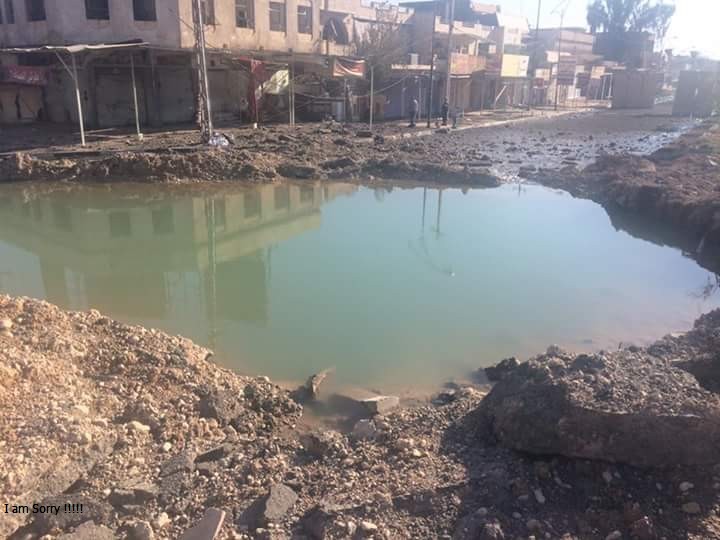
الاضرار
التي تسببت بها الحرب لمشاريع المياه وانابيبها
في خضم تحقيقنا هذا
وبعد الاطلاع على الواقع الصحي ومعاناة الناس اليومية
طرقنا ابواب المسؤولين في الموصل لاستيضاح المشكلة
ومسبباتها وللوقوف على التقصير الحكومي في معالجة هذه
المشكلة فاتجهنا الى نائب محافظ نينوى لشؤون التخطيط
الاستاذ حسن العلاف واتصلنا به واستفسرنا منه عن اسباب
انقطاع المياه عن الموصل حيث أفادنا بأن للمشكلة شقين
اثنين اولهما: قيام تنظيم الدولة بتخريب ثلاث محطات
وهي الكبة والسدة والقصور وإخراجها عن الخدمة بالكامل،
والمحطة الوحيدة الفعالة في الايسر هي محطة الساهرون
وهي تعمل بصورة متقطعة، وثانيهما الاضرار والتكسرات
التي اصابت انابيب المياه الناقلة نتيجة قصف التحالف
الجوي لتقطاعات الطرق في الموصل.
وعن دور الحكومة
المحلية في معالجة الازمة قال إنه وبعد اكمال استعادة
الجانب الايسر من الموصل بالكامل بدأت فرق الهندسة في
دائرة ماء نينوى باصلاح تكسرات الانابيب الناتجة عن
قصف التحالف الدولي، اما ما يخص محطات المياه فإن
الكوادر الهندسية تمكنت من الوصول الى بعض تلك المحطات
وبدأنت بإحصاء الاضرار ومحاولة اصلاحها وفق الامكانات
المتوفرة لديهم.
المعلومات التي
حصلنا عليها من نائب محافظ نينوى لم تكن كافية
لتحقيقنا فبحثنا عن مزيد من المعلومات من الدوائر ذات
العلاقة وبعد محاولات عدة وجهد جهيد ويومين من
الاتصالات المكثفة استطعنا الوصول الى مدير ماء نينوى
الاستاذ مرعي حسن قلندر واطلعناه على ما توصلنا اليه
من معلومات رسمية وغير رسمية، وعن الاضرار الحقيقية
والدقيقة التي تسببت بها الحرب لمشاريع المياه
وانابيبها في الجانب الايسر من الموصل قال: "إن انقطاع
المياه يعود الى سببين رئيسيين يتمثل الاول بالتكسرات
التي احدثها القصف الجوي للتحالف الدولي لتقاطعات
الطرق والتي ادت الى اضرار جسيمة بالانابيب الرئيسة
الناقلة للمياه خصوصا في الاجزاء الشرقية من المدينة،
ولو كان الامر ممكنا لرفعنا دعوى قضائية ضد التحالف
الدولي على ما سببه من أذى وخراب، واضاف أنهم بدأوا
بالعمل على اصلاح هذه الانابيب واستكملوا اصلاح ما
نسبته 70% منها تقريبا.
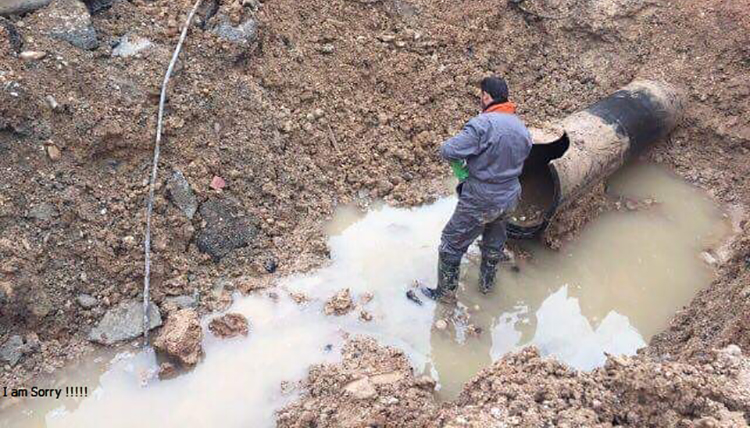
أما السبب الثاني
فيتمثل بمشاريع المياه فلدينا اربع مشاريع رئيسة في
الايسر ومشروع آخر فرعي وصغير، تتمثل هذه المشاريع
بمشروع الايسر الجديد "الكبة" حيث كان يزود المدينة بـ
13000 متر مكعب من المياه في الساعة وليس لدينا معلومة
دقيقة عن نسبة الاضرار فيه كونه يقع على نهر دجلة
مباشرة في الحيز الضيق للنهر ولم تتمكن فرقنا الهندسية
من الوصول اليه حتى الان. أما المشروع الثاني فهو
مشروع الايسر القديم "القصور" وكانت قدرته التشغيلية
تصل الى 7000 متر مكعب في الساعة وتبلغ نسبة الاضرار
فيه 50% نتيجة تضرر وحدات السحب والدفع والتخزين.
المشروع الثالث هو مشروع الزهور "السدة" ويقع في الجهة
المقابلة لمنطقة الميدان قرب الجسر القديم ولا تستطيع
فرقنا الهندسية الوصول اليه ايضا حيث أن المسافة بينه
وبين الضفة الغربية للنهر هي 150 مترا فقط. المشروع
الرابع هو مشروع "الساهرون" في الجزء الجنوبي الشرقي
للمدينة وهو مشروع متكامل ولم يتعرض لاي ضرر وتبلغ
قدرته التشغيلية 5000 متر مكعب في الساعة وبدأنا
تشغيله قبل اسبوع تقريبا بمعدل ثلاث ساعات في اليوم
اعتمادا على مولدات الديزل الموقعية، حيث أن محطة
الساهرون هذه تزود أحياء سومر وفلسطين ودوميز ويارمجة
وجليوخان بالمياه.اما المشروع الخامس فهو مشروع
الرشيدية وهو مشروع صغير تبلغ قدرته 750 مترا مكعبا في
الساعة ويغذي منطقة الرشيدية فقط وهو بحالة تحتاج الى
اعمال صيانة وتأهيل فقط وتبلغ نسبة ضرره 20% " .
وفيما يخص الكلفة
التقديرية لاعادة تأهيل تلك المشاريع واعادتها الى
وضعها السابق اضاف قلندر بأن أغلب التخصيصات المالية
الخاصة بدائرتنا انفقت في اصلاح تكسرات الانابيب
الناتجة عن قصف التحالف الدولي للتقاطعات داخل
المدينة، أما إصلاح واعادة تأهيل مشاريع المياه فتحتاج
الى اموال طائلة لا تتوفر لدينا ولا بد من الدعم
الحكومي المباشر حيث أن اصلاح مشروع الايسر القديم وهو
مشروع "القصور" يحتاج الى ما يقرب من مليارين وسبعمائة
مليون دينار عراقي اي ما يعادل 2 مليون دولار تقريبا
واضاف قائلا إنه ورغم كل المخاطر الامنيةالا أن فرقنا
الهندسية تعمل الان على اصلاح ما يمكن اصلاحه من
المشروع ولو بصورة جزئية.
وعن المدة المتوقعة
لاصلاح مشروع الايسر القديم "القصور" فيما لو توفرت
الاموال اللازمة قال قلندر: "في حال توفر الاموال
اللازمة والمعدات فنستطيع تشغيل المشروع في مدة لا
تتجاوز الشهر من الان".
عدنا بتحقيقنا هذا
مرة اخرى الى نائب محافظ نينوى لشؤون التخطيط حسن
العلاف للاستفسار منه عن الدعم المالي المقدم من
الحكومة المحلية لمحافظة نينوى ومن الحكومة الاتحادية
حيث أفادنا بأن حكومة نينوى المحلية لا تملك الموارد
المالية اللازمة لاعادة تأهيل مشاريع المياه هذه
والامر يعود في هذه الحالة الى الحكومة المركزية في
بغداد والامر قد يستغرق اشهرا عدة، وبالتالي نطمح في
دعم من المنظمات الدولية والامم المتحدة وإنه قد تم
بالفعل افتتاح عدة مشاريع في جنوب الموصل بالتعاون مع
عدد من هذه المنظمات وإن دائرة ماء نينوى لديها تفاصيل
اكثر.
وعن المنظمات
الدولية وما قدمته من دعم في إعادة تأهيل بعض المشاريع
اتصلنا مرة أخرى بمدير ماء نينوى حيث أكد أن اغلب
المشاريع التي تم تأهيلها في قاطع جنوب الموصل ضمن
قاطع القيارة كانت بدعم مباشر من منظمة الصليب الاحمر
الدولي ومنظمة الـ UNDP التابعة للامم المتحدة ومنظمة
IOM خصوصا في منطقة الحاج علي والقيارة، كما أكد أن
دائرة ماء نينوى قدمت الدراسة الاولية لاعادة تأهيل
مشروع الايسر القديم "القصور" الى تلك المنظمات
وبأنتظار ما ستؤول اليه الامور.
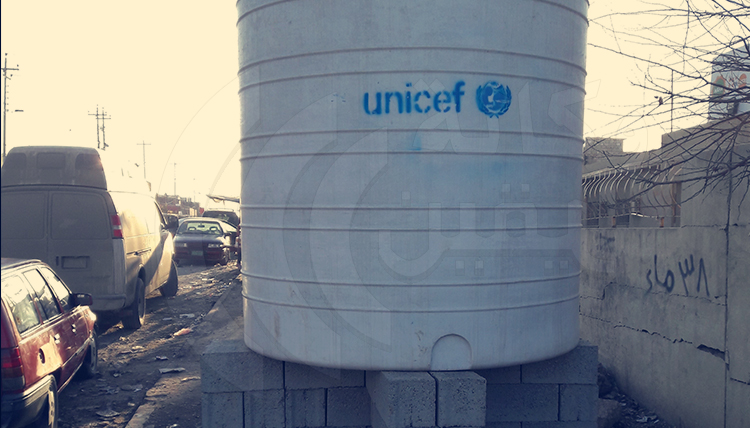
حلول مؤقتة
... لا تلبي الحاجة الماسة للمياه
في ظل هذه المعاناة
وبعد الاطلاع على عدد من الحالات الانسانية كان لا بد
لنا من الاستفسار عن البدائل او الحلول البديلة التي
قد تساعد الناس في تخفيف وطأة هذه المعاناة فاتجهنا
للمرة الاخيرة الى المسؤول المباشر عن المياه في نينوى
وهو مدير ماء نينوى مرعي حسن قلندر حيث أوضح أنهم
بدأوا قبل شهر بتسيير ارتال حوضية تغذي الساحل الايسر
من الموصل بمياه الشرب النقية من الابار النظامية في
منطقة بازوايا – قرب مدينة برطلة - بمعدل 1300 متر
مكعب في اليوم توزع على المواطنين مباشرة او تفرغ في
خزانات مياه كبيرة تصل سعتها الى 5000 لتر منتشرة في
احياء المدينة كانت منظمة اليونيسيف قد قامت بنصبها
بين الاحياء حتى يستخدمها الاهالي في الشرب وأن هذه
المياه كان قد تم فحصها مختبريا وأنها صالحة للشرب.
كما أضاف أنهم يعملون على ربط مزيد من الاحياء بمحطة
الساهرون في الجزء الجنوبي الشرقي من الموصل حتى تصل
المياه الى اجزاء من أحياء الوحدة والضباط والميثاق
فضلا عن قيامهم باستحداث شمعات مياه في محطة الساهرون
– انابيب ثابتة - حتى يستطيع السكان من الاحياء
القريبة الاخرى من التزود بمياه الشرب من خلالها ولو
بكميات قليلة".
ونتيجة لتحقيقنا
المطول في حيثيات انقطاع المياه عن سكان الجانب الايسر
من مدينة الموصل، للقارىء أن يتخيل كم من الوقت سيمضي
دون أن يكون هناك حل ناجع لمشكلة انقطاع المياه في خضم
الوضع الامني الراهن وانعدام التخصيصات المالية.
حيث سيستمــــر
العطش لماء دجلة في الموصل التي تتربع على عرش بلاد
الرفدين في انتظار بارقة أمل لا يعلم أحد متى ستأتي.
http://yaqein.net/AR/details9732.htm
|
***
The following are news stories from a
pro-Iraqi government website (http://www.iraqinews.com/),
which usually reports those who are killed by Iraqi government attacks
as Islamic State fighters, implying no civilians were killed by bombing
residential neighborhoods:
***
Hundreds of displaced persons from Mosul and Deir ez-Zour
arrive in Haska
by Loaa Adel
Feb 12, 2017, 5:03 pm
Nineveh (IraqiNews.com)
Two new patches of displaced people from the Iraqi city of Mosul and
Syrian city of Deir ez-Zour arrived in the city of Haska in western
Kurdistan (Syrian Kurdistan), fleeing battles against the Islamic State
in the two cities, Bas News reported on Sunday.
The administration of al-Hawl Camp said in a press statement, “Today,
198 Iraqis and 66 Syrians arrived in the camp,” adding that, “253 Iraqis
and 104 Syrians arrived in the camp on Friday and Saturday.”
“Numbers of Iraqi refugees inside the camp reached 14500 persons,
while Syrian refugees reached more than 900 persons,” the statement
added.
Hundreds of Iraqi refugees arrive in al-Hawl IDP Camp through the
border line with Iraq, south of Haska, which is controlled by Syrian
Kurdish units.
***
The following are news stories from the US Department of
Defense website (http://www.defense.gov/News)
:
***
Counter-ISIL Strikes Continue in Syria, Iraq
SOUTHWEST ASIA, Feb. 12, 2017 —
Strikes in Syria
Attack, fighter and remotely piloted aircraft conducted 14 strikes in
19 engagements in Syria:
-- Near Abu Kamal, two strikes destroyed nine oil tanker trucks and
an oil wellhead.
-- Near Al Bab, a strike engaged an ISIL tactical unit and destroyed
a heavy machine gun.
-- Near Ar Raqqah seven strikes destroyed two oil stills, two
tunnels, a tunnel system, an anti-air artillery system, an ISIL-held
building and a bridge.
-- Near Dayr Az Zawr, four strikes destroyed eight oil tanker trucks,
an oil wellhead and an oil still.
Strikes in Iraq
Attack, bomber, fighter, rotary and remotely piloted aircraft, as
well as artillery, conducted six strikes consisting of 28 engagements in
Iraq, coordinated with and in support of Iraq’s government:
-- Near Irbil, a strike engaged an ISIL tactical unit; destroyed an
ISIL-held building and a weapons cache.
-- Near Mosul, five strikes engaged two ISIL tactical units;
destroyed 13 watercraft, three mortar systems, two front-end loaders,
two supply caches, two ISIL-held buildings, two pieces of engineering
equipment, and a tank, damaged three supply routes, and suppressed two
mortar teams.
Officials Provide Details of Latest Counter-ISIL Strikes in
Syria, Iraq
SOUTHWEST ASIA, Feb. 10, 2017 —
Strikes in Syria
Attack, bomber, fighter and remotely piloted aircraft conducted 14
strikes in 28 engagements in Syria:
-- Near Abu Kamal, two strikes destroyed 23 oil storage tanks, two
oil tanker trucks and an oil wellhead.
-- Near Raqqa, 10 strikes engaged two ISIL tactical units; destroyed
five tunnels, three vehicles, two mortar systems and a fighting
position; and damaged three supply routes.
-- Near Dayr Az Zawr, a strike destroyed an oil wellhead.
-- Near Palmyra, a strike destroyed a vehicle bomb factory
Strikes in Iraq
Fighter and remotely piloted aircraft and artillery conducted nine
strikes in 34 engagements in Iraq, coordinated with and in support of
Iraq’s government:
-- Near Kisik, one strike engaged an ISIL tactical unit and destroyed
a supply cache.
-- Near Mosul, four strikes, engaged an ISIL tactical unit and an
ISIL mortar team; destroyed a vehicle and a vehicle bomb; damaged eight
supply routes; and suppressed 15 mortar teams.
-- Near Qayyarah, two strikes destroyed a weapons cache and damaged
four supply routes.
-- Near Qaim, two strikes engaged two ISIL tactical units and
destroyed three vehicles.
Counter-ISIL Strikes Continue in Syria, Iraq
SOUTHWEST ASIA, Feb. 9, 2017 —
Strikes in Syria
Fighter and remotely piloted aircraft conducted 17 strikes consisting
of 21 engagements in Syria:
-- Near Bab, three strikes engaged two ISIL tactical units and
destroyed two mortar systems, a vehicle-borne bomb, a vehicle and a
tunnel entrance.
-- Near Raqqa, 14 strikes engaged five ISIL tactical units; destroyed
two fighting positions, two tunnel entrances, a tactical vehicle, a
vehicle and an improvised explosive device; and damaged six supply
routes.
Strikes in Iraq
Bomber, fighter and remotely piloted aircraft, as well as artillery
and rocket artillery, conducted 12 strikes consisting of 43 engagements
in Iraq, coordinated with and in support of the Iraqi government:
-- Near Haditha, a strike engaged an ISIL tactical unit; destroyed
two weapons caches, a fighting position and an ISIL-held building; and
suppressed a mortar team.
-- Near Kirkuk, a strike engaged an ISIL tactical unit and destroyed
two ISIL-held buildings.
-- Near Kisik, a strike engaged two ISIL tactical units and destroyed
a supply cache and damaged a tunnel.
-- Near Mosul, six strikes engaged six ISIL tactical units; destroyed
five watercraft, four vehicles, three excavators, three engineering
equipment pieces, two ISIL-held buildings, a weapons cache, an ISIL
headquarters, a front-end loader, a crane, a mortar system, a backhoe
and a command-and-control node; damaged five supply routes; and
suppressed six mortar teams.
-- Near Qayyarah, a strike damaged three supply routes.
-- Near Tuz, a strike damaged a supply route.
U.S., Coalition Continue Strikes Against ISIL in Syria, Iraq
SOUTHWEST ASIA, Feb. 7, 2017 —
Strikes in Syria
Attack, fighter and remotely piloted aircraft conducted 17 strikes
consisting of 28 engagements in Syria:
-- Near Abu Kamal, a strike destroyed an oil wellhead.
-- Near Ayn Isa, a strike destroyed a vehicle-borne bomb.
-- Near Palmyra, nine strikes destroyed 17 heavy-equipment vehicles,
11 vehicles, four dump trucks, three front-end loaders, three
vehicle-borne bombs and two tanks.
-- Near Raqqa, six strikes destroyed three tunnels, a weapons
facility, a vehicle and an oil wellhead.
Strikes in Iraq
Fighter aircraft and ground-based artillery conducted seven strikes
consisting of 42 engagements in Iraq, coordinated with and in support of
the Iraqi government:
-- Near Beiji, a strike destroyed two tactical vehicles.
-- Near Haditha, a strike engaged an ISIL tactical unit and destroyed
an ISIL-held building, a vehicle and a supply cache.
-- Near Kisik, a strike engaged an ISIL tactical unit and destroyed
an ISIL-held building and a supply cache.
-- Near Mosul, four strikes engaged four ISIL tactical units and an
ISIL staging area; destroyed two watercraft, two supply caches, two
weapons caches, a barge, a bunker, a dump truck, a front-end loader, a
mortar system, a vehicle, a vehicle-borne-bomb facility and an anti-air
artillery system; and damaged 16 supply routes and a tunnel.
Military Strikes Hit ISIL in Syria, Iraq
SOUTHWEST ASIA, Feb. 6, 2017 —
Strikes in Syria
Attack, bomber, fighter and remotely piloted aircraft conducted 16
strikes in 18 engagements in Syria:
-- Near Abu Kamal, three strikes destroyed five oil wellheads.
-- Near Dayr Az Zawr, seven strikes destroyed nine oil tanker trucks,
six oil wellheads and a pumpjack.
-- Near Raqqa, six strikes destroyed three tunnels, an artillery
system, a vehicle bomb and an ISIL headquarters.
Strikes in Iraq
Bomber, fighter and remotely piloted aircraft and rocket artillery
conducted nine strikes in 27 engagements in Iraq, coordinated with and
in support of Iraq’s government:
-- Near Huwayjah, a strike engaged an ISIL tactical unit, destroyed
two ISIL-held buildings and damaged a tunnel.
-- Near Kisik, a strike engaged an ISIL tactical unit and destroyed
an ISIL-held building and a command-and-control node.
-- Near Mosul, three strikes destroyed 23 ISIL-held buildings, an
ISIL headquarters and a front-end loader; and damaged 14 supply routes
and a tunnel.
-- Near Qaim, a strike destroyed three bunkers.
-- Near Rawah, two strikes engaged an ISIL tactical unit and
destroyed a vehicle, a tactical vehicle and a vehicle bomb.
-- Near Tuz, a strike engaged an ISIL tactical unit and destroyed two
ISIL-held buildings and a vehicle.
Coalition Strikes Target ISIL in Syria, Iraq
SOUTHWEST ASIA, Feb. 5, 2017 —
Strikes in Syria
Attack, bomber, fighter and remotely piloted aircraft conducted 21
strikes in 25 engagements in Syria:
-- Near Abu Kamal, a strike destroyed an ISIL tanker truck, two oil
stills and three oil storage tanks.
-- Near Ayn Isa, a strike engaged an ISIL tactical unit and destroyed
a fighting position.
-- Near Dayr Az Zawr, two strikes destroyed an ISIL pump jack and an
oil wellhead.
-- Near Idlib, a strike engaged an ISIL tactical unit and destroyed a
vehicle.
-- Near Palmyra, a strike destroyed an ISIL tank.
-- Near Raqqa, 15 strikes engaged five ISIL tactical units; destroyed
11 oil tanker trucks, three oil storage tanks, three tunnels, two
fighting positions, two oil pumpjacks, a vehicle and a command and
control node; and damaged three supply routes.
Strikes in Iraq
Bomber, fighter and remotely piloted aircraft and rocket artillery
conducted 11 strikes in 38 engagements in Iraq, coordinated with and in
support of Iraq’s government:
-- Near Beiji, a strike engaged an ISIL tactical unit and destroyed a
vehicle.
-- Near Haditha, a strike engaged an ISIL tactical unit.
-- Near Huwayjah, a strike destroyed an improvised explosive device
factory.
-- Near Kirkuk, a strike destroyed an ISIL vehicle bomb.
-- Near Mosul, five strikes engaged an ISIL tactical unit; destroyed
three watercraft, a vehicle bomb, a barge, a vehicle, an unmanned
aircraft and an artillery system; and damaged 18 supply routes.
-- Near Qaim, a strike engaged an ISIL tactical unit and destroyed a
vehicle.
-- Near Rawah, a strike engaged an ISIL tactical unit and destroyed a
vehicle and a mortar system.
Airstrikes Continue Against ISIL Terrorists in Syria, Iraq
SOUTHWEST ASIA, Feb. 4, 2017 —
Strikes in Syria
Attack, bomber and fighter aircraft and rocket artillery conducted 31
strikes in 45 engagements in Syria:
-- Near Abu Kamal, seven strikes destroyed 14 oil wellheads and two
oil refinement stills.
-- Near Bab, three strikes engaged two ISIL tactical units; destroyed
two tactical vehicles, two heavy machine guns and two fighting
positions; and damaged a command and control node.
-- Near Idlib, a strike destroyed a fighting position.
-- Near Raqqa, 20 strikes engaged four ISIL tactical units; destroyed
11 oil tanker trucks, six oil barrels, three oil refinement stills, two
fighting positions, two tunnels, two vehicles, an ISIL headquarters, an
oil storage tank and a command and control node; and damaged 16 supply
routes.
Strikes in Iraq
Attack, fighter and remotely piloted aircraft and rocket artillery
conducted seven strikes in 18 engagements in Iraq, coordinated with and
in support of Iraq’s government:
-- Near Huwayjah, a strike destroyed an improvised explosive device
factory.
-- Near Irbil, a strike destroyed a front-end loader and a dump
truck.
-- Near Mosul, five strikes engaged two ISIL tactical units;
destroyed eight watercraft, three vehicle bombs, two barges, a vehicle
and an artillery system; damaged three supply routes; and suppressed a
mortar team.
Airstrikes Continue Against ISIL in Syria, Iraq
SOUTHWEST ASIA, Feb. 4, 2017 —
Strikes in Syria
Attack, bomber and fighter aircraft and rocket artillery conducted 31
strikes in 45 engagements in Syria:
-- Near Abu Kamal, seven strikes destroyed 14 oil wellheads and two
oil refinement stills.
-- Near Bab, three strikes engaged two ISIL tactical units; destroyed
two tactical vehicles, two heavy machine guns and two fighting
positions; and damaged a command and control node.
-- Near Idlib, a strike destroyed a fighting position.
-- Near Raqqa, 20 strikes engaged four ISIL tactical units; destroyed
11 oil tanker trucks, six oil barrels, three oil refinement stills, two
fighting positions, two tunnels, two vehicles, an ISIL headquarters, an
oil storage tank and a command and control node; and damaged 16 supply
routes.
Strikes in Iraq
Attack, fighter and remotely piloted aircraft and rocket artillery
conducted seven strikes in 18 engagements in Iraq, coordinated with and
in support of Iraq’s government:
-- Near Huwayjah, a strike destroyed an improvised explosive device
factory.
-- Near Irbil, a strike destroyed a front-end loader and a dump
truck.
-- Near Mosul, five strikes engaged two ISIL tactical units;
destroyed eight watercraft, three vehicle bombs, two barges, a vehicle
and an artillery system; damaged three supply routes; and suppressed a
mortar team.
Counter-ISIL Strikes Continue in Syria, Iraq
SOUTHWEST ASIA, Feb. 3, 2017 —
Strikes in Syria
Attack, bomber and fighter aircraft conducted 31 strikes in 40
engagements in Syria:
-- Near Abu Kamal, two strikes engaged an ISIL tactical unit and
destroyed a vehicle and an oil inlet manifold.
-- Near Bab, four strikes engaged three ISIL tactical units;
destroyed two fighting positions; and damaged a command-and-control
node.
-- Near Dayr Az Zawr, three strikes destroyed three oil wellheads and
two oil tanker trucks.
-- Near Raqqa, 21 strikes engaged four ISIL tactical units; destroyed
53 oil barrels, 39 oil storage tanks, four oil wellheads, four tunnel
entrances, two tunnels, two vehicles, two unmanned aerial vehicles, a
fighting position and a tank; and damaged eight supply routes.
-- Near Shadaddi, a strike engaged an ISIL tactical unit.
Strikes in Iraq
Bomber, fighter and remotely piloted aircraft and rocket artillery
conducted 10 strikes in 24 engagements in Iraq, coordinated with and in
support of Iraq’s government:
-- Near Kirkuk, a strike engaged an ISIL tactical unit and destroyed
a supply cache and an ISIL-held building.
-- Near Kisik, two strikes engaged an ISIL tactical unit and
destroyed two vehicles, a supply cache, a fighting position and a
tunnel.
-- Near Mosul, four strikes engaged two ISIL tactical units;
destroyed an artillery system, a checkpoint and a bunker; and damaged
three supply routes.
-- Near Rawah, a strike destroyed two fuel storage tanks and a
vehicle bomb facility.
-- Near Tal Afar, two strikes destroyed a vehicle, a tactical vehicle
and a vehicle bomb.
Military Strikes Target ISIL in Syria, Iraq
SOUTHWEST ASIA, Feb. 2, 2017 —
Strikes in Syria
Attack, bomber and fighter aircraft and rocket artillery conducted 16
strikes in 19 engagements in Syria:
-- Near Abu Kamal, four strikes destroyed four oil wellheads, two oil
storage tanks and an oil pumpjack.
-- Near Bab, a strike destroyed four ISIL-held buildings.
-- Near Dayr Az Zawr, four strikes destroyed two oil pump jacks, an
oil tanker truck and an oil wellhead.
-- Near Raqqa, seven strikes destroyed an oil storage tank, an oil
barrel, an oil inlet manifold, an oil separation tank, a vehicle bomb, a
tunnel and a weapons storage facility; and damaged a supply route.
Strikes in Iraq
Bomber, fighter and remotely piloted aircraft and rocket artillery
conducted five strikes in 19 engagements in Iraq, coordinated with and
in support of Iraq’s government:
-- Near Kisik, a strike engaged an ISIL staging area.
Coalition Strikes Continue Against ISIL Terrorists in Syria,
Iraq
SOUTHWEST ASIA, Feb. 1, 2017 —
Strikes in Syria
Attack, bomber and fighter aircraft conducted 11 strikes in 16
engagements in Syria:
-- Near Abu Kamal, five strikes destroyed six oil wellheads, five
front-end loaders, a bulldozer and an oil tanker.
-- Near Ayn Isa, three strikes damaged three supply routes.
-- Near Raqqa, three strikes destroyed 20 oil barrels, three tunnels,
an oil inlet manifold and an oil storage tank.
Strikes in Iraq
Attack, fighter and remotely piloted aircraft conducted five strikes
in 11 engagements in Iraq, coordinated with and in support of Iraq’s
government:
-- Near Huwayjah, a strike engaged an ISIL tactical unit and
destroyed a fighting position and a supply cache.
-- Near Kirkuk, a strike engaged an ISIL tactical unit and destroyed
a fighting position, a supply cache and an observation post.
-- Near Kisik, a strike engaged an ISIL tactical unit and damaged a
tunnel.
-- Near Rutbah, two strikes destroyed three vehicles and a vehicle
bomb.
***
Share the link of this article with your facebook friends






